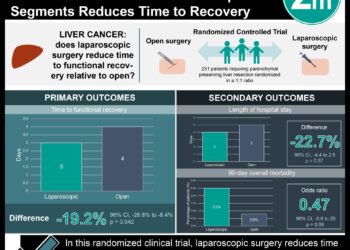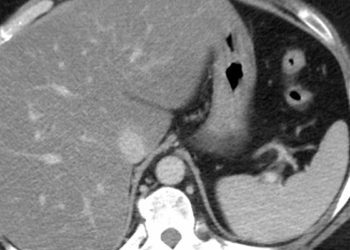CT texture analysis may predict liver insufficiency after hepatectomy
1. In patients undergoing partial hepatectomy, pre-operative CT scans of liver parenchyma revealed less homogenous texture in patients who went on to develop hepatic insufficiency post-operatively.
2. Pre-operative texture analysis of CT scans may be useful in risk stratification for post-operative hepatic insufficiency.
Evidence Rating Level: 3 (Average)
Study Rundown: Post-operative liver insufficiency is a major source of morbidity and mortality in patients undergoing hepatic resection for cancer. While a higher risk for hepatic insufficiency has shown to be correlated with a greater extent of hepatic resection, no predictive value has been demonstrated from passive or dynamic liver function tests. The authors of this study, consequently, sought to explore the use of texture analysis of liver parenchyma on CT to pre-operatively predict a patient’s risk for the development of hepatic insufficiency after a hepatectomy. Texture analysis involves the a quantification of spatial variations in pixel intensities in an area of interest and clinically can be used to detect variations in intravenously administered enhancement not readily visible by inspection on CT. Prior to this study, texture analysis has been used to diagnose and characterize tumors and fibrotic lesions as well as predict survival of colorectal cancer. The present study found increased variability and heterogeneity in CT scans of hepatic parenchyma of patients who developed hepatic insufficiency compared to matched controls who did not. Such a difference could be suggestive of a future role for texture analysis in pre-operatively identifying patients who are at a highest risk for developing insufficiency after surgery. However, the study is limited under its current design. For one, contrast enhancement is susceptible to a number of factors including cardiac output and venous congestion as well as extrahepatic patient characteristics which could have influenced the texture analysis reported in the study. Other limitations include the retrospective design and small sample size.
Click to read the study in Journal of American College of Surgeons
Relevant Reading: Colorectal Cancer: Texture Analysis of Portal Phase Hepatic CT Images as a Potential Marker of Survival
In-Depth [retrospective study]: Out of a database of 1721 resections and 367 major resections, 16 patients with post-operative liver insufficiency between 2006 and 2012 were identified. Three patients who underwent a pre-operative portal vein embolization procedure and 1 with a poor quality scan were excluded. Patients were matched to controls who did not develop hepatic insufficiency 2:1 by procedure, remaining liver volume, and year of procedure. Pre-operative and post-contrast CT scans were obtained for each patient and texture analysis was performed using standard gray-level co-occurrence matrices (GLCM). Five features: contrast (local variation), correlation (brightness interdependence on neighboring pixels), energy (local homogeneity), entropy (randomness in brightness variation), and homogeneity, were collected from the texture analysis for each patient. Patients with hepatic insufficiency post resection demonstrated a reduced measure of correlation (p<0.05) and increased measure of entropy (p<0.05) by texture analysis. No mortalities were noted after 90 days in the 24 patients who did not develop liver insufficiency, compared to 6 (50%) of 12 with hepatic sufficiency (p<0.01).
More from this author: Roux-en-Y gastric bypass may slow progression of diabetic retinopathy, Vitamin deficiency may persist after Omega-loop gastric bypass, Age-related confounders may contribute to heart transplant mortality
Image: PD
©2014 2 Minute Medicine, Inc. All rights reserved. No works may be reproduced without expressed written consent from 2 Minute Medicine, Inc. No article should be construed as medical advice and is not intended as such by the authors, editors, staff or by 2 Minute Medicine, Inc.






![Injectable loaded microparticle scaffolds improve vaccine responses in mice [PreClinical]](https://www.2minutemedicine.com/wp-content/uploads/2014/12/Vaccination_US_Navy-75x75.jpg)